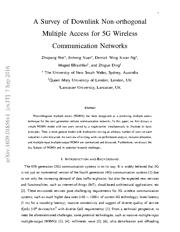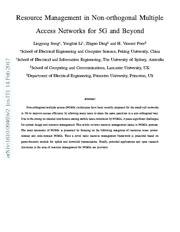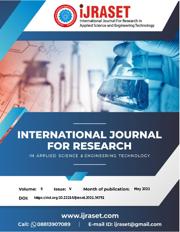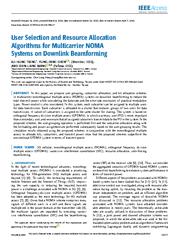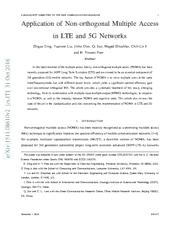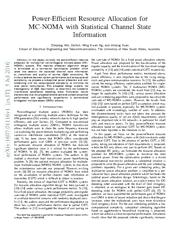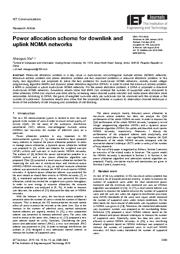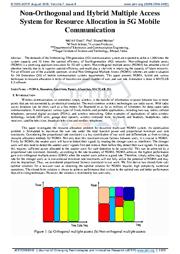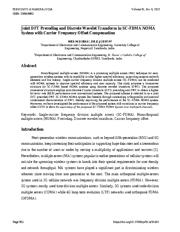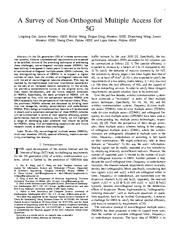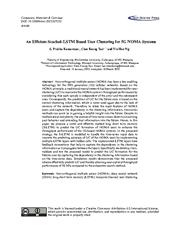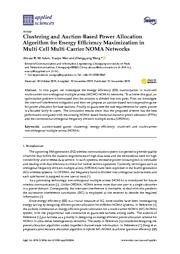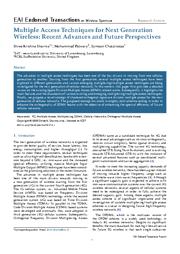A copy of this work was available on the public web and has been preserved in the Wayback Machine. The capture dates from 2020; you can also visit the original URL.
The file type is application/pdf.
Filters
A Survey of Downlink Non-orthogonal Multiple Access for 5G Wireless Communication Networks
[article]
2016
arXiv
pre-print
Non-orthogonal multiple access (NOMA) has been recognized as a promising multiple access technique for the next generation cellular communication networks. ...
An overview of existing works on performance analysis, resource allocation, and multiple-input multiple-output NOMA are summarized and discussed. ...
Furthermore, the authors in [21] studied a joint power and subcarrier allocation problem for a two-user MC-NOMA system. ...
arXiv:1609.01856v1
fatcat:apus5bsuyfczxormp7w7wz4bve
Resource Management in Non-orthogonal Multiple Access Networks for 5G and Beyond
[article]
2017
arXiv
pre-print
Non-orthogonal multiple access (NOMA) schemes have been proposed for the next generation of mobile communication systems to improve the access efficiency by allowing multiple users to share the same spectrum ...
in a non-orthogonal way. ...
For PD-NOMA, coalitional game modes can be used in the downlink and non-cooperative power control games can be applied to the uplink to realize user and subcarrier grouping. ...
arXiv:1610.09465v2
fatcat:7z63ahtrhre55bbn3uq4qw62qu
Performance Analysis of OFDMA vs. NOMA in Cognitive Radio Network
2021
International Journal for Research in Applied Science and Engineering Technology
Recent advancements in communication systems have resulted in a new class of multiple access schemes known as non-orthogonal multiple access (NOMA), the primary goal of which is to increase spectrum efficiency ...
Initially, the combination of SCMA and orthogonal frequency division multiplexing (OFDM) is addressed, establishing a baseline for the overall SER performance of the multiple access strategy. ...
INTRODUCTION The notion of non-orthogonal multiple access (NOMA) for future 5G networks. ...
doi:10.22214/ijraset.2021.34751
fatcat:d7m2aqx3evafnfmiyz7duglkfe
User Selection and Resource Allocation Algorithms for Multicarrier NOMA Systems on Downlink Beamforming
2020
IEEE Access
In this system, each subcarrier can be assigned to multiple users for data transmission. Each subcarrier is allocated to a cluster that contains groups of two users for data transmission. ...
In this paper, we propose user grouping, subcarrier allocation, and bit allocation schemes in multicarrier nonorthogonal multiple access (NOMA) systems on downlink beamforming to reduce the total transmit ...
In [33] , a resource allocation algorithm design was investigated for such a system with a scenario of multiple-input single-output multicarrier non-orthogonal multiple access. ...
doi:10.1109/access.2020.2982677
fatcat:bd6xt5rhe5b5jnwip4dhqsn7la
Application of Non-orthogonal Multiple Access in LTE and 5G Networks
[article]
2016
arXiv
pre-print
As the latest member of the multiple access family, non-orthogonal multiple access (NOMA) has been recently proposed for 3GPP Long Term Evolution (LTE) and envisioned to be an essential component of 5th ...
The key feature of NOMA is to serve multiple users at the same time/frequency/code, but with different power levels, which yields a significant spectral efficiency gain over conventional orthogonal MA. ...
In addition to MUST, there are other forms of non-orthogonal multiple access schemes, e.g., sparse code multiple access (SCMA), pattern division multiple access (PDMA), multiuser shared multiple access ...
arXiv:1511.08610v2
fatcat:srsluzrv6fg4pdzoh5eespp2p4
Joint Transmission in QoE-Driven Backhaul-Aware MC-NOMA Cognitive Radio Network
[article]
2020
arXiv
pre-print
For the primary tier, we consider orthogonal frequency division multiple access (OFDMA) scheme and also Quality of Service (QoS) to evaluate the user satisfaction. ...
In particular, we formulate a joint optimization problem of power control and scheduling (i.e., user association and subcarrier allocation) in secondary tier to maximize total achievable QoE for the secondary ...
To enhance spectral reuse, multi-carrier non-orthogonal multiple access (MC-NOMA) is a potential technique that allows multiple users' transmissions over the same subcarrier [2] , [3] . ...
arXiv:2008.13269v1
fatcat:ycmze4obunhalpec5pfgsdon7q
Compressive Sensing-Based User Clustering for Downlink NOMA Systems With Decoding Power
2018
IEEE Signal Processing Letters
This letter investigates joint power control and user clustering for downlink non-orthogonal multiple access systems. ...
Our aim is to minimize the total power consumption by taking into account not only the conventional transmission power but also the decoding power of the users. ...
INTRODUCTION Non-orthogonal multiple access (NOMA) has been deemed as a promising technology for future fifth generation systems [1] - [3] . ...
doi:10.1109/lsp.2018.2817181
fatcat:6ez2sl3gljcztghuixefnpxd5m
Power-Efficient Resource Allocation for MC-NOMA with Statistical Channel State Information
[article]
2016
arXiv
pre-print
In this paper, we study the power-efficient resource allocation for multicarrier non-orthogonal multiple access (MC-NOMA) systems. ...
To strike a balance between system performance and computational complexity, we propose a suboptimal power allocation and user scheduling with low computational complexity to minimize the total power consumption ...
INTRODUCTION Non-orthogonal multiple access (NOMA) has been recognized as a promising multiple access technique for the fifth-generation (5G) wireless networks due to its high spectral efficiency and user ...
arXiv:1607.01116v1
fatcat:qpuwujdcjrhqfbsbsto5p62wta
Power Allocation scheme for Downlink and Uplink NOMA Networks
2019
IET Communications
Resource allocation problem is a key issue in multi-carrier non-orthogonal multiple access (NOMA) networks. ...
In order to solve the maximum access problem, a MIPA is proposed in uplink multi-carrier NOMA networks. For the power allocation problem, a DPAA is proposed in downlink multi-carrier NOMA networks. ...
On the basis of the successive interference cancellation (SIC) scheme, non-orthogonal multiple access (NOMA) can maximise the number of admitted users on a spectrum. ...
doi:10.1049/iet-com.2019.0066
fatcat:tz5jyi7erzegnlut5ltrcf6kre
Non-Orthogonal and Hybrid Multiple Access System for Resource Allocation in 5G Mobile Communication
2020
Zenodo
Non-orthogonal multiple access (NOMA) is a promising applicant innovation for 5G cell systems. ...
For an efficient use of the available spectrum, several Non-Orthogonal Multiple Access (NOMA) schemes are under evaluation for 5th Generation (5G) of mobile communication systems requirements. ...
Yang et al., [2] This letter investigates joint power control and user clustering for downlink nonorthogonal multiple access systems. ...
doi:10.5281/zenodo.4553329
fatcat:5e3girw7k5hxrolqe26p5oiggu
Joint DFT Precoding and Discrete Wavelet Transform in SC-FDMA NOMA System with Carrier Frequency Offset Compensation
2022
TAGA Journal
Single-carrier frequency division multiple access (SC-FDMA) can be combined with NOMA systems to improve spectral efficiency and user capacity. ...
Nonorthogonal multiple access (NOMA) is a promising multiple access (MA) technique for nextgeneration wireless systems with its capability to offer higher spectral efficiency, supporting massive network ...
The main orthogonal multiple-access system used in 1G cellular network was frequency division multiple access (FDMA). However, 2G systems mostly used time-division multiple access. ...
doi:10.37896/pd91.4/91463
fatcat:2yghjj3tyngqjgnwn7pcr6nu3e
A Survey of Non-Orthogonal Multiple Access for 5G
2018
IEEE Communications Surveys and Tutorials
slots with the aid of non-orthogonal resource allocation. ...
As one of the promising techniques of addressing these challenges, non-orthogonal multiple access (NOMA) has been actively investigated in recent years. ...
Specifically, for 1G, 2G, 3G, and 4G wireless communication systems, frequency division multiple access (FDMA), time division multiple access (TDMA), code division multiple access (CDMA), and orthogonal ...
doi:10.1109/comst.2018.2835558
fatcat:ycxmkfe3rjet7eikctqijc554m
An Efficient Stacked-LSTM Based User Clustering for 5G NOMA Systems
2022
Computers Materials & Continua
Non-orthogonal multiple access (NOMA) has been a key enabling technology for the fifth generation (5G) cellular networks. ...
Hence, in this paper, we propose a novel and effective stacked long short term memory (S-LSTM) to predict the UC formation of NOMA users to enhance the throughput performance of the 5G-based NOMA systems ...
In this context, the sum throughput of the NOMA system is defined as the objective function, and the joint clustering and power allocation problem for throughput maximization in a downlink NOMA system ...
doi:10.32604/cmc.2022.027223
fatcat:dvzfxez5yzfotm4olkl6dwrzoe
Clustering and Auction-Based Power Allocation Algorithm for Energy Efficiency Maximization in Multi-Cell Multi-Carrier NOMA Networks
2019
Applied Sciences
In this paper, we investigate the energy efficiency (EE) maximization in multi-cell multi-carrier non-orthogonal multiple access (MCMC-NOMA) networks. ...
First, we investigate the inter-cell interference mitigation and then we propose an auction-based non-cooperative game for power allocation for base stations. ...
As a promising technology, non-orthogonal multiple access (NOMA) is introduced for future wireless communication [2] . ...
doi:10.3390/app9235034
fatcat:klhkrjkghjadzln3ol732eushq
Multiple Access Techniques for Next Generation Wireless: Recent Advances and Future Perspectives
2016
EAI Endorsed Transactions on Wireless Spectrum
Finally, we propose a novel concept of clustered orthogonal signature division multiple access for the next generation of cellular networks. ...
Starting from the first generation, several multiple access techniques have been explored in different generations and various emerging multiplexing/multiple access techniques are being investigated for ...
Subsequently, we propose a novel clustered orthogonal signature multiple access scheme for the next generation of cellular networks. ...
doi:10.4108/eai.19-1-2016.151002
fatcat:7yxosuz675efvpme6b47bm5idu
« Previous
Showing results 1 — 15 out of 1,033 results

